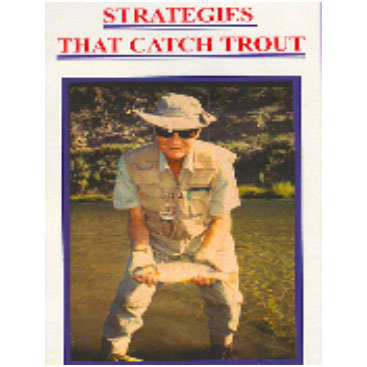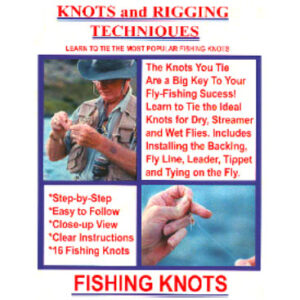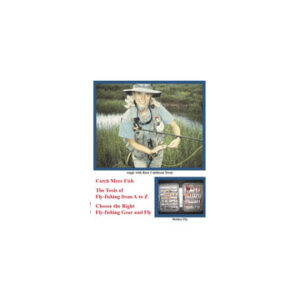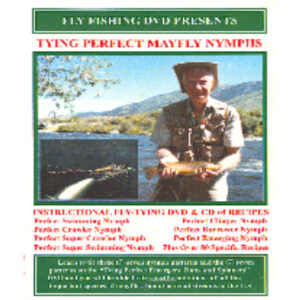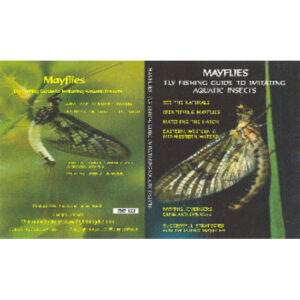“Fly Fishing Strategies That Catch Trout” covers the game plans that anglers use to catch trout under the varying conditions encountered on different streams at various times of the season. It explains how to go about matching the hatch, fishing when there is no hatch and the when specific or impressionistic imitations works best to your advantage. It reveals how, when and where attractor flies are useful. Learn how to determine whether trout are feeding opportunistically or selectively and how to handle either with proficiency and confidence. It explains the timing and occurrence of hatches and how to adjust and utilize hatch chart information. Learn how to read trout waters and locate trout fishing banks, riffles, runs, pools, pocket water, current eddies and seams and still waters.
An Example of some of the subject matter: What Fly to Use: Remember this one very important thing. The main reason you need to know the species of insects the trout are feeding on and the stage of life they are in at the time, is not so much to be able to match the natural with a perfect imitation. It is necessary in order that you know “how” to fish.
Often, you can get by with a fly that just gets close to matching the natural. No always, but often. But you will never get results fishing something the trout are not eating at the time or in places where there are not any feeding trout. About the only thing that you can say positive about a fish is that if there is not any there, you not going to catch one. That is a fact.
Should you be fishing a nymph or larvae imitation instead of a dry fly? Should the nymph or larvae be presented dead-drift near the bottom to imitate naturals that are drifting with the current or with action? Are nymphs crawling along the bottom to shore to hatch or are they swimming? Should you be trying to imitate nymphs or pupae that are emerging? Maybe you should be imitating adults that have just emerged and are departing the water seconds later? Should you be imitating flies that are laying eggs by touching the water in flight? Are the flies you see diving to the bottom to lay their eggs? Would you be better off imitating flies that have fallen spent on the surface?
Are you fishing where insects are emerging or laying eggs? If there is no action occurring where you are fishing, is something going on somewhere else in slower moving water, calm water; faster water of the riffles, fast water in the runs, or pocket water? Are the insects that are hatching, or more importantly, about to hatch, mayflies, caddisflies, stoneflies or should you be trying to match emerging midges. If none of this activity is happening, and that is often the case, when will something happen? Would you be wise to stay until dark or head for the nearest bar and try again tomorrow? If you do not know what the trout are feeding on, or worse, know if they are even feeding or not, you really just don’t know what you are doing. Even if you are aware that trout are feeding on a certain type of insect but do not know what stage of activity is occurring at the time, you still may be relying on pure luck. Fortunately for some of us, it is sometimes “good luck” and we still manage to catch a few without knowing anything much other than the name of the stream we are fishing.
How Fly-fishing Got Started:
Most likely, many, many years ago, some curious human being, probably a very hungry one, noticed a trout approach the surface of the water and gulp down a fly. Undoubtedly, the idea hit he or she, to catch a fly (maybe a grasshopper} put it on the end of something (who knows, the end of a small vine attached to a stick), and then catch a trout. That person did just that and to their amazement, it worked.
This is how fly-fishing started; but that is only the beginning of the story. Upon returning to the cave with the trout, the person, no doubt was asked, first “how did you catch that ”, and after receiving that bit of information, finally asked the question that they thought would uncover the secret to it all – “what fly did you use to catch it on”? We know this is how fly-fishing got started because nothing about it has changed. Until this day, the first question the “knowledgeable” fly fisher is asked by other anglers is still the same one, “what fly did you use”?
In this presentation, we are not going to tell you “what fly to use”. What we are going to tell you is how, when and where to find trout and how to catch them on the fly. By the time we are finished, we hope that “you” will be able to either, figure out “what fly to use”, or if not, at least, how to fool the trout into thinking you have.
DVD Menu:
How Fly-fishing Got Started
Matching the Hatch
Choosing the Best Method
Using Attractor Flies
Choosing the Right Fly
Using Hatch Charts
Hatch Abundance
Finding Trout-Banks
Finding Trout-Riffles
Finding Trout-Pocket Water
Bubbles
Finding Trout-Pools
Fly Fishing Small Streams
Never forget that choosing the right fly is not the single most important thing. You can catch trout in most any stream on any one good nymph or any one good attractor dry fly, most of the time. It must be said, however, that when a hatch is on, that consist of insects that your nymph or dry fly does not’t imitate very well, and you are not willing to try to match it, you may be wise to move to another location.
Knowing how to match the hatch can be very beneficial and will certainly increase your odds of success. Don’t forget, however, that knowing what type of water to fish, exactly where to cast the fly and how to present it effectively, among many other things are equally, if not more, just as important.
When you examine the bottom of the stream in a riffle, you will usually find a very diversified topography. Pockets, holes and crevices of all types and sizes create current changes of various speeds and directions. Not all of the water is moving swiftly in the same direction it may appear to be doing. From an elevation perspective, a certain spot may have faster moving currents at and near the surface and slower moving currents near the bottom. This provides an ideal place for a trout to rest, expending little energy fighting strong currents, with a constant supply of food passing a very short distance away in easy reach.
Look for areas of the riffles that have the most bubbles, floating leaves, debris, etc. Most likely, it also has the most food and consequently, is a good spot to catch a surface feeding trout. Each and every rock provides some type of current change, that not only may provide an ideal place for a trout to rest, hide and feed, it may also provide the perfect home for nymphs. Stoneflies and caddisflies hatch in the riffles. Never overlook them.
The rough water characteristic of streams and rivers with a lot of pocket water, usually allows you the opportunity to get closer to trout than calm water. It is usually approached best in an upstream direction. This allows you to make short cast of only fifteen to twenty feet in most cases. Short cast not only give you more control over your line and fly, it lets you quickly pick up and cast again to a rising fish or good looking spot. In other words, you can keep your fly in the prime locations and not waste time in unproductive water. Also, you don’t waste a lot of time stripping in line. The short cast permits you to cast again without making false cast that can spook fish. Yet even another advantage is that the short upstream cast prevents you from having to make cast across the mixed currents of the rough water and reduces the drag.
Length: 62 min. plus promos 20 min. Total of 1 hour, 02 min.
